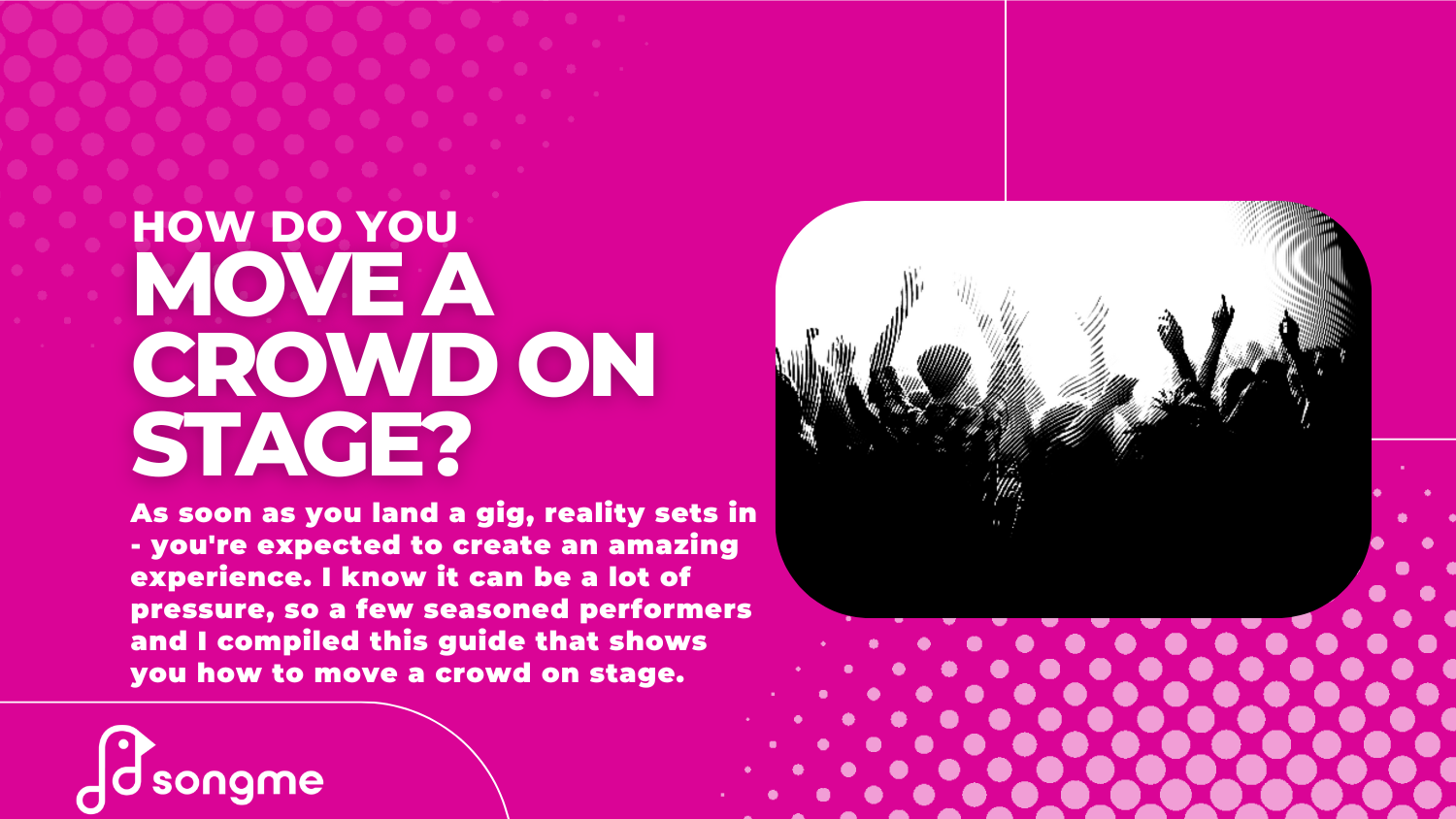How Do You Move a Crowd on Stage?
So, you got the big gig, the excitement fades to dread as the reality of doing something amazing on stage quickly sinks in - pressure city, right? I've been there, which is why a few seasoned performers and I compiled this guide on how to move a crowd on stage.
To move a crowd on stage, musicians need to make the performance about the crowd, not themselves. The best performers engage the entire audience early on, speak directly to superfans, and work the whole "room" throughout.
Plus, they always end the show with a bang - which psychology indicates the ending is what folks will remember most.
While music is personal, your audience came to have a good time, not be your therapist. So it's worth mentioning again that going all in on making the experience for the audience is the most important thing a performer can do.
If you’re nervous about the crowd at your next gig shoegazing or crosstalking while you’re on stage, fear not. Create a plan following our guide here and you'll have them hanging onto every note. Let’s dig in.
3 Ways to Move a Crowd on Stage (Plus 1 Brain Hack to Getting Rave Reviews)
As mentioned, it’s important to remember that the purpose of live music is for the audience to experience your work uniquely, otherwise, they would just listen to your music at home, and you would be playing in an empty room.
Which is sad - you don't want that.
So, What Does It Mean to Make It About Them and Not You?
It starts with the attitude you cultivate before you even get on stage. Recognize they came out to see you, but also that you’re a means for them to have a fantastic night.
Your performance is a vehicle for their good times, which requires losing a bit of your ego the moment you get under the bright lights. But if you start with the right attitude, the rest of these things will come easily.
If making it about the audience is the price of entry to a great performance, then the following three (plus a bonus fourth) tips are how you level up moving any crowd.
1. Speak to the Audience Early in the Set
While there is merit in making a big entrance with one of your most energetic songs, going too far into the set without speaking to the audience tells them you don’t really recognize their presence.
It sends a message that you’re on stage to do your own thing and they just happen to be in the room. That's not the vibe you want to start with.
One of the best starts to a show I ever experienced was when Foo Fighters (RIP Taylor Hawkins) played a show in Lexington, KY in 2019.
The show had been previously canceled last minute due to a family emergency - so the anticipation was at a peak with the reschedule.
When Dave Grohl took to the stage, Taylor was playing a kick drum beat and some hi-hats as a backing for the welcome.
Dave said, “Kentucky, we missed you! We’re sorry about last time, and we have some making up to do, so get f*cking comfortable because we’re going to be here for a while.”
The crowd immediately forgot any negativity about the canceled show.
As Dave and the band launched into “Run” off their latest album, the whole arena started jumping. It was an unforgettable night and it started just right.
That's not the only way to start a set though, there are other tricks to connecting with the audience early in a show.
For instance, dinking and talking is when you play the opening chord of a song repeatedly while telling the audience a little bit about the history and meaning of the song.
Talking about what you and the band were doing before the show is another good one: what time did you get there? Did you go eat somewhere local before the show?
For a full breakdown of the art of conversation while performing, and I do mean full, check out my article on "What Should You Say to an Audience at a Gig."
It goes deep into the acts of a show and is filled with some of the best in the business showing their talents on NPR's Tiny Desk Concerts.
No matter what you choose, make sure you talk to the audience early AND throughout the entire show. This is the #1 way to get them engaged early and keep them plugged in for the entirety of your set.
2. Speak directly to your superfans
If you are an established touring band, you likely have some superfans. You know the type: they were at the venue hours before doors so they could score a spot on the rail, they know all your lyrics, and they bring the most energy to show.
You can draft off their vibes, creating a virtuous cycle of hyping each other up to keep the energy high for the whole show.
Former lead singer Jess Schmitt says that a key to her success is making eye contact with the front row and just asking simple questions, such as:
"What’s your name?"
"Who are you here with?"
"What have you enjoyed about the night so far?"
It doesn’t have to be clever, being sincere works best.
If you're new or this seems a bit awkward to tackle, try creating your own set of superfan questions to ask at every show. Sure, your band is going to know what you’re going to say but no one else will.
And because you’re talking with individuals, their answers will vary every time.
The most important thing is these people will tell everyone they know about their interaction with you, so make it good and they will provide you with tons of positive word of mouth.
Don’t waste that opportunity!
3. Work the Whole Room
I know it can be hard to see everyone in the audience, and it's incredibly dependent on the lighting setup, but everyone in your crowd wants to connect to your music - even if they aren’t on the rail.
In a practical sense, what does working a room look like?
Think about the room as four quadrants: left front, right front, left back, and right back. If you're new or struggle with working a room, keep it simple and break the room into halves. Try alternating quadrants throughout a song.
Or for beginners, just focus on halves of the room during a song - and if you're feeling super green to this, make the first half of a song about one half in the room, and the other half of a song about the rest of the room.
It's important to note that not everyone wants to deal with the crush at the front, so don’t forget about the fans in the back.
The people in the back get left out a lot - give them some love.
Ok, so working a room is not all science - feelings, and emotion play a large role as well. Just like a song, a good song is part science part feeling.
Working a room through the feeling of sound
Connor Gray Johnson, the guitarist of heavy metal band Stagecoach Inferno, has this advice for working rooms:
“Project yourself to the back of the audience for the more intense parts of the set, and project yourself to the front of the audience for softer spots in the set.”
That’s his general rule for focus, but he gets more specific.
“From there, try and study where the dead parts in the audience are appearing, and throw in mixtures and surprises of where your presence is aiming, and what you’re physically doing to engage. Certain things work in certain spots in the crowd that doesn’t work in others.”
No matter how you choose to "work" your crowd, remember that everyone there deserves to have a good time.
Keep that in mind as you look out at your fans - it's your job to engage them so much that there's no need for side conversations or checking their phone.
BONUS: End with a bang to get great reviews
There's a well-known concept to behavioral economists (yes that's a thing) and motivational psychologists (yes that's also a thing) called the Peak-End Rule.
The name is perfect - people form their opinion on an experience based on two things - the peak moment and the end. Instead of the total experience and all the moments in between.
This has obvious implications for a show - as a performer, you can’t always know what everyone’s favorite song will be so each individual’s “peak” is probably different.
But what you can fully control is how you choose to end the set, and if you make that the peak as well - it's a bit of a double whammy. I suppose that's what an encore is made for.
Ending it with your biggest song is a well-known tactic, but you could also consider a few other methods that are less expected.
Q&A with the audience
Throwing out merch or items used that night
Pyrotechnics or a contrasting light performance
Covering a popular song
Last year I saw Phoebe Bridgers in Louisville, KY. The show felt concluded so I scurried off to grab a beer - and I thought she was done, since she had already returned for an encore, playing her most popular song.
And what did I hear as I handed over some bills to the beer tent vendor? She started into her cover of Bo Burnham’s “That Funny Feeling.”
I went sprinting back to my seat (spilling most of the beer) because I was so excited to hear her cover a song that so resonated with me at the time.
I’ve been talking about that show for almost a year now and it still gives me chills to think of how she sounded singing such a melancholic but funny song.
Because of the Peak-End Rule, people will judge your show to be better if they left feeling really good.
If you’ve got something special saved for that evening, save it for the end. Your fans will love it, and you’ll love the good reviews.
If you want to move a crowd on stage, you've probably picked up that it's not just a moment in time, and it's not just one picking a spot in the room.
Moving a crowd on stage is complex - comprised of many moments and parts of the room that you engage throughout an entire performance; reaching a crescendo with the Peak-End Rule.

